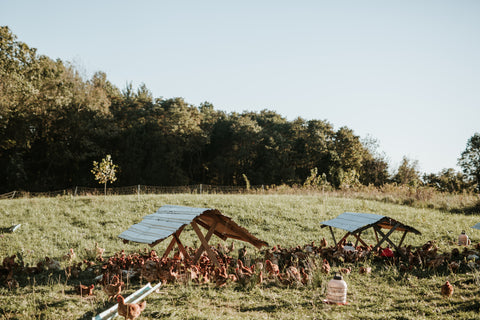
As someone who raises six species of animals on rotating fresh pastures, I'm curious about the increasing trend of food marketers using the term "pastured" to describe their products. Some of these marketers have identified that a growing number of consumers have caught on to them: that when it comes to animal products and byproducts in the marketplace, the terms "cage free," "natural," "free-range" and even "organic" have become basically meaningless in terms of discernible food quality, animal welfare, and land stewardship differences.
When we began a farm, we grew just vegetables. We decided, in part, to raise animals because we saw that a farm is an ecosystem that can be either healthy and functioning or unhealthy and poorly functioning. Healthy, functioning ecosystems always have animals. And the animals in healthy ecosystems move around or spread out. They do this because they exhaust their food resources, they want to trick predators (or prey), and because God didn't bless them with indoor plumbing - and nobody ever lived a healthy, happy life wading around in their own feces. Nature's laws require that any animal concentration be mobile, period: That's why you will find bald eagle mating pairs with a permanent nest and scores of acres of territory. But if you have any significant concentration: a family of wild pigs or up to a million-strong wildebeest herd, they will be almost constantly moving.
So from the start we saw that in order for us to have a farm that functioned like an ecosystem, producing good and healthy outcomes for land, livestock, wildlife, and customers, the animals would have to move across the pasture and forest almost daily, with very few and limited exceptions. For practitioners in the pasture-based agriculture space, the movement of animals has always been a prerequisite for a system to be called "pastured". (This is the "what" of pasture-based farming: a minimum definition. I won't get into "why" or "how" so much here. But I've done so in previous blog posts, and will continue to do so in the future.)

Which brings me to the other guys: The reality is 5000 laying hens or 10,000 broilers or 300 hogs in a stationary barn are living in confinement. If the building is stationary and the door is open, then they are, at best, yard birds or dirt lot pigs. It is virtually impossible for them to have consistent access to fresh forages each day because they will denude and foul the entire reach-able area within a short number of days, and keep it that way for as long as they impact the site. But "pasture" is on the label. To many of us raising animals on pasture, the gap between the claim and the reality is stark. Furthermore, you may be shocked to know that many of these products are actually being offered at higher prices than actually-pastured products.
I know it can be demoralizing to learn that the food-buying landscape is even more full of liars, pretenders, and confusion. But if you want to eat animal products and byproducts from pasture-based systems, there are ways to find meats and eggs that actually have all of the benefits of truly pasture-raised goods, such as healthier omega 3:6 ratios and higher levels of CLA's (which, among other things, have been shown to kill cancer cells in a petri dish) and many vitamins and minerals and far better flavor.
- Whenever possible, buy from a farmer you can trust. This is usually easier to do locally. Though in the past this required forgoing some convenience, there are a growing number of options out there to consider that can bring the meat straight to your door, whether a local-based Meat CSA like ours, or some of the authentically pasture-based meat-shipping retailers out there. Eatwild.com is also a great resource for farms that have met some meaningful basic requirements all around the United States.
- Ask questions about what animals were fed, how they lived their lives, and whether or not their housing and other infrastructure is mobile.
- Be skeptical of many label claims. For instance, "108 square feet per bird" is one often used on egg cartons these days. Many using this claim are including areas the chickens are either excluded from, or are hypothetically allowed to reach, but would never travel that far due to the distance from the barn to the edge of the pasture, even if they choose to go outside. These systems usually have a denuded area around the barn and an overgrown area where few hens ever explore. There is also a six-tier, fully-audited system for meat created by a popular national retailer. It sounds like a useful tool for consumers. The problem is that all six tiers say nothing of mobile infrastructure and housing for chickens or other poultry, even though they use the term "pastured" for a number of the tiers. The parameters of a confinement environment are in the definitions of all six steps. So products labeled as "step five or six pastured poultry" might sound like the top of the line, but it isn't even required to be pastured. And in many cases it isn't -by the definitions I laid out above. Beware of marketing ploys like these.
- Ask your retailer, distributor, or restaurant where they source their proteins from. Or even better, you could confirm with the source what the retailer is saying (It happens all the time that some restaurants will claim they are buying from a producer, while they are not - essentially stealing their credibility). In the end, those who would obfuscate and pretend can get away with it as long as nobody asks questions and declares their preferences.

The good news is that there are a growing number of farmers all across the world producing real pastured poultry, meat, and eggs at various scales, and in many different kinds of systems. The thing we all hold in common is that we move our animals. Just beware of the pretenders.
